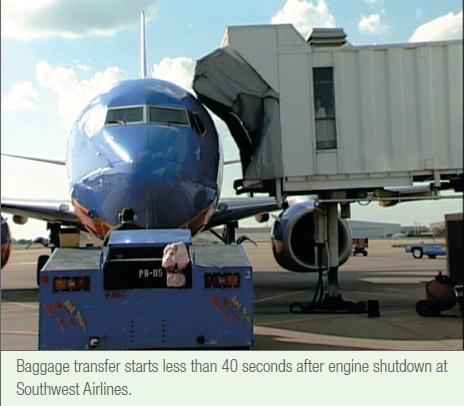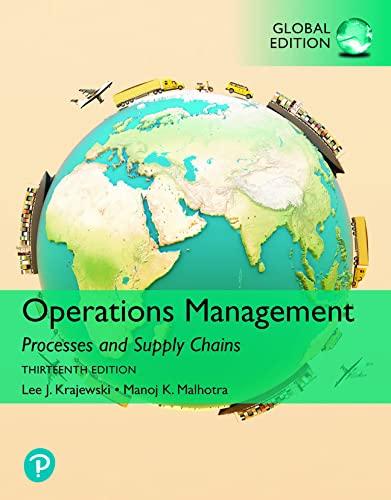Rollin King and Herb Kelleher started Southwest Airlines in 1971 with this idea: If they could take
Question:
Rollin King and Herb Kelleher started Southwest Airlines in 1971 with this idea: If they could take airline passengers where they want to go, on time, at the lowest possible price, and have a good time while doing it, people would love to fly their airline. The result? No other airline in the industry’s history has enjoyed the customer loyalty and extended profitability for which Southwest is now famous. There’s more to the story, however, than making promises and hoping to fulfill them. A large part of the success of Southwest Airlines lies in its ability to plan long-term capacity to better match demand and also improving the utilization of its fleet by turning around an aircraft at the gate faster than its competitors. Capacity at Southwest is measured in seat-miles, and even a single minute reduction in aircraft turnaround time systemwide means additional seat-miles being added to the available capacity of Southwest Airlines. As soon as an aircraft calls "in range" at one of Southwest's airport locations, called a station, the local operations manager notifies the ground operations team so that the team can start mobilizing all the parties involved in servicing the aircraft in preparation for its next departure. The grounds operations team consists of a baggage transfer driver who has responsibility for getting connecting flight bags to their proper planes, a local baggage driver who moves bags to baggage claim for passenger pickup, a lavatory truck driver who handles restroom receptacle drainage, a lead gate agent to handle baggage carts and track incoming and outgoing bag counts, and a bin agent to manage baggage and cargo inside the plane. The ground operations team knows it must turn the plane around in 25 minutes or less. The clock starts when the pilot sets the wheel brakes.
Inbound and outbound flights are coordinated by the supervisors between all of Southwest's airport stations through the company's Operations Terminal Information System (OTIS). Each local supervisor is able to keep track of flights and manage any delays or problems that may have crept into the system by keeping in touch with headquarters in Dallas for systemwide issues that may affect a local station, along with using the OTIS information coming from stations sending flights their way.
Just what, exactly, does it take to turn around an aircraft? In-bound flight 3155 from Phoenix to Dallas's Love Field is a good example. In Phoenix, the operations coordinators and ground operations team push back the plane as scheduled at 9:50 a.m. The flight is scheduled to arrive at 3:35 p.m. in Dallas.
The Phoenix team enters into OTIS the information the ground operations team will need in Dallas, such as wheelchairs, gate-checked baggage, cargo bin locator data, and other data needed to close out the flight on their end. This action lets the Dallas station know what to expect when the plane lands. In Dallas, the local ground operations coordinators have been monitoring all 110 inbound flights and now see Phoenix flight 3155 in the system, scheduled for an on-time arrival. When the pilot calls "in range" as it nears Dallas, the ground crew prepares for action. As the plane is guided to its "stop mark" at the gate, the lead agent waits for the captain's signal that the engines have been turned off and brakes set.
Within just 10 seconds, the provisioning truck pulls up to open the back door for restocking supplies such as drinks and snacks. The waiting fuel truck extends its hose to the underwing connection and in less than 2 minutes picks up refueling instructions and starts to load fuel. As soon as the aircraft is in position, the operations team steers the jetway into position and locks it against the aircraft. The door is opened, the in-flight crew is greeted, and passengers start to deplane.
Outside, less than 40 seconds after engine shutdown, baggage is rolling off the plane and gets placed onto the first cart. Any transfer bags get sent to their next destination, and gate-checked bags are delivered to the top of the jetway stairs for passenger pickup.
While passengers make their way out of the plane, the in-flight crew helps clean up and prepare the cabin for the next flight. If all goes well, the last passenger will leave the plane after only 8 minutes. By this time, passengers waiting to board have already lined up in their designated positions for boarding.
The gate agent confirms that the plane is ready for passenger boarding and calls for the first group to turn in their boarding passes and file down the jetway.
At the completion of boarding, the operations agent checks the fuel invoice, cargo bin loading schedule with actual bag counts in their bins from the baggage agents, and a lavatory service record confirming that cleaning has taken place. Final paperwork is given to the captain. The door to the aircraft is closed, and the jetway is retracted. Thirty seconds later, the plane is pushed back and the operations agent gives a traditional salute to the captain to send the flight on its way. Total elapsed time: less than 25 minutes.
Managing Southwest's capacity has been somewhat simplified by strategic decisions made early on in the company's life. First, the company's fleet of aircraft is all Boeing 737s. This single decision affects all areas of operations- from crew training to aircraft maintenance. The single-plane configuration also provides Southwest with crew scheduling flexibility. Since pilots and flight crews can be deployed across the entire fleet, there are no constraints with regard to training and certification pegged to specific aircraft types.
The way Southwest has streamlined its operations for tight turnarounds means it must maintain a high capacity cushion to accommodate variability in its daily operations. Anything from weather delays to unexpected maintenance issues at the gate can slow down the flow of operations to a crawl. To handle these unplanned but anticipated challenges, Southwest builds into its schedules enough cushion to manage these delays yet not so much that employees and planes are idle. Additionally, the company encourages discussion to keep on top of what's working and where improvements can be made. If a problem is noted at a downstream station-say, bags were not properly loaded-this information quickly travels back up to the originating station for correction so that it does not happen again.
Even with the tightly managed operations Southwest Airlines enjoys, company executives know that continued improvement is necessary if the company is to remain profitable into the future. Company executives know they have achieved their goals when internal and external metrics are reached. For example, the Department of Transportation (DOT) tracks on-time departures, customer complaints, and mishandled baggage for all airlines. The company sets targets for achievement on these dimensions and lets employees know on a monthly basis how the company is doing against those metrics and the rest of the industry. Regular communication with all employees is delivered via meetings, posters, and newsletters. Rewards such as prizes and profit sharing are given for successful achievement.
As for the future, Bob Jordan, Southwest's executive vice president for strategy and planning, puts it this way: "We make money when our planes are in the air, not on the ground. If we can save one minute off every turn system-wide, that's like putting five additional planes in the air. If a single plane generates annual revenue of $25 million, there's $125 million in profit potential from those time savings."
QUESTIONS
1. How can capacity and utilization be measured at an airline such as Southwest Airlines?
2. Which factors can adversely impact turnaround times at Southwest Airlines?
3. How does Southwest Airlines know it is achieving its goals?
4. What are the important long-term issues relevant for managing capacity, revenue, and customer satisfaction for Southwest Airlines?
Step by Step Answer:

Operations Management Processes And Supply Chains
ISBN: 9781292409863
13th Global Edition
Authors: Lee Krajewski, Naresh Malhotra, Larry Ritzman





